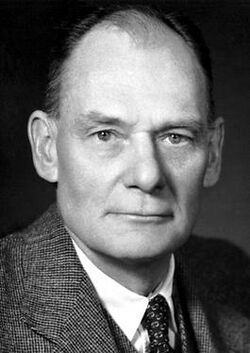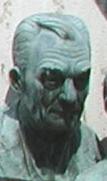Biography:John Franklin Enders
John Franklin Enders | |
|---|---|
 Enders in 1954 | |
| Born | West Hartford, Connecticut |
| Died | September 8, 1985 (aged 88) Waterford, Connecticut |
| Nationality | American |
| Education | St. Paul's School |
| Alma mater | Yale University Harvard University |
| Known for | culturing poliovirus, isolating measlesvirus, developing measles vaccine |
| Awards | Albert Lasker Award for Basic Medical Research (1954) Nobel Prize in Physiology or Medicine (1954) Cameron Prize for Therapeutics of the University of Edinburgh (1960) |
John Franklin Enders (February 10, 1897 – September 8, 1985) was an American biomedical scientist and Nobel Laureate. Enders has been called "The Father of Modern Vaccines."[1][2]
Life and education
Enders was born in West Hartford, Connecticut on February 10, 1897.[3] His father, John Ostrom Enders, was CEO of the Hartford National Bank and left him a fortune of $19 million upon his death.[1] He attended the Noah Webster School in Hartford,[4] and St. Paul's School in Concord, New Hampshire.[3][5] After attending Yale University a short time, he joined the United States Army Air Corps in 1918 as a flight instructor and a lieutenant.
After returning from World War I, he graduated from Yale, where he was a member of Scroll and Key as well as Delta Kappa Epsilon. He went into real estate in 1922, and tried several careers before choosing the biomedical field with a focus on infectious diseases, gaining a PhD at Harvard in 1930. He later joined the faculty at Children's Hospital Boston.[3]
Enders died at his summer home in Waterford, Connecticut, aged 88, on 8 September 1985.[4] His wife died in 2000.
Biomedical career
In 1949, Enders, Thomas Huckle Weller, and Frederick Chapman Robbins reported successful in vitro culture of an animal virus—poliovirus.[6] The three received the 1954 Nobel Prize in Physiology or Medicine "for their discovery of the ability of poliomyelitis viruses to grow in cultures of various types of tissue".[7]
Meanwhile, Jonas Salk applied the Enders-Weller-Robbins technique to produce large quantities of poliovirus, and then developed a polio vaccine in 1952. Upon the 1954 polio vaccine field trial, whose success Salk announced on the radio,[8] Salk became a public hero but failed to credit the many other researchers that his effort rode upon, and was somewhat shunned by America's scientific establishment.[9]
In 1954, Enders and Thomas C. Peebles isolated measlesvirus from an 11-year-old boy, David Edmonston.[10] Disappointed by polio vaccine's development and involvement in some cases of polio and death—what Enders attributed to Salk's technique—Enders began development of measles vaccine.[10] In October 1960, an Enders team began trials on 1,500 mentally retarded children in New York City and on 4,000 children in Nigeria.[11] Refusing credit for merely himself when The New York Times announced the measles vaccine effective on September 17, 1961, Enders wrote to the newspaper to acknowledge the work of various colleagues and the collaborative nature of the research.[4][11] In 1963, a deactivated measles vaccine and an attenuated measles vaccine were introduced by Pfizer and Merck & Co., respectively.[12]
He continued to work in virology research till the late 1970s and retired from the laboratory at the age of 80.[4][13]
Honors
- 1946: Fellow of the American Academy of Arts and Sciences[14]
- 1953: Member of the American Philosophical Society[15]
- 1954: Nobel Prize in Physiology or Medicine (together with Frederick Chapman Robbins and Thomas Huckle Weller)[7][16][17]
- 1954: Albert Lasker Award for Basic Medical Research[18]
- 1955: Kyle Award from the U.S. Public Health Service[19]
- 1955: Member of the American Philosophical Society[20]
- 1958: inducted into the Polio Hall of Fame[21]
- 1960: Cameron Prize for Therapeutics of the University of Edinburgh[22][23]
- 1962: Robert Koch Prize[24]
- 1963: Presidential Medal of Freedom[25]
- 1963: Science Achievement Award from the American Medical Association[26]
- 1967: Foreign Member, The Royal Society[1]
Enders also held honorary doctoral degrees from 13 universities.[27]
See also
- Anna Mitus
References
- ↑ 1.0 1.1 1.2 Tyrrell, D. A. J. (1987). "John Franklin Enders. 10 February 1897-8 September 1985". Biographical Memoirs of Fellows of the Royal Society 33: 212–226. doi:10.1098/rsbm.1987.0008. PMID 11621434.
- ↑ Katz SL (2009). "John F. Enders and Measles Virus Vaccine—a Reminiscence". Measles. Current Topics in Microbiology and Immunology. 329. pp. 3–11. doi:10.1007/978-3-540-70523-9_1. ISBN 978-3-540-70522-2.
- ↑ 3.0 3.1 3.2 "John F. Enders - Biographical". Nobel Prize Outreach AB. https://www.nobelprize.org/prizes/medicine/1954/enders/biographical/.
- ↑ 4.0 4.1 4.2 4.3 Ofgang, Erik (12 August 2020). "How a Connecticut scientist became the 'Father of Modern Vaccines'" (in en). Connecticut Magazine (September 2020). https://www.connecticutmag.com/health-and-science/how-a-connecticut-scientist-became-the-father-of-modern-vaccines/article_bc81b116-dcae-11ea-a4dc-ef095c688062.html.
- ↑ Thomas H Weller & Frederick C Robbins, A Biographical Memoir: John Franklin Enders (1897–1985), (Washington DC: National Academy of Sciences, 1991), p 48.
- ↑ "Cultivation of the Lansing strain of poliomyelitis virus in cultures of various human embryonic tissues". Science 109 (2822): 85–87. 1949. doi:10.1126/science.109.2822.85. PMID 17794160. Bibcode: 1949Sci...109...85E.
- ↑ 7.0 7.1 "The Nobel Prize in Physiology or Medicine 1954". https://www.nobelprize.org/prizes/medicine/1954/enders/facts/. "Prize motivation: for their discovery of the ability of poliomyelitis viruses to grow in cultures of various types of tissue."
- ↑ "Salk announces polio vaccine" . History.com. 2010. Retrieved 31 Jan 2010.
- ↑ Balik R, "On this day: Polio vaccine declared safe", FindingDulcinea, 12 Apr 2011.
- ↑ 10.0 10.1 Baker JP (2011). "The first measles vaccine". Pediatrics 128 (3): 435–7. doi:10.1542/peds.2011-1430. PMID 21873696.
- ↑ 11.0 11.1 Bakalar N, "First mention: Measles vaccine, 1960", New York Times, 5 Oct 2010, p D2.
- ↑ Webb, Nicholas. "HSL Research Guides: Ernst Ludwig Wynder Autograph Collection: John Enders, Ph.D." (in en). New York Medical College Health Sciences Library. https://guides.library.nymc.edu/c.php?g=117959&p=767676. "In 1963, Pfizer introduced a deactivated measles vaccine, and Merck & Co introduced an attenuated measles vaccine."
- ↑ Thomas H Weller & Frederick C Robbins, A Biographical Memoir: John Franklin Enders (1897–1985), (Washington DC: National Academy of Sciences, 1991), p 60.
- ↑ "Book of Members, 1780–2010: Chapter A". American Academy of Arts and Sciences. http://www.amacad.org/publications/BookofMembers/ChapterA.pdf.
- ↑ "John F. Enders". http://www.nasonline.org/member-directory/deceased-members/56004.html.
- ↑ "How a CT man who majored in English at Yale became the 'Father of Modern Vaccines'" (in en-US). 2020-09-08. https://www.ctinsider.com/news/nhregister/article/How-a-CT-man-who-majored-in-English-at-Yale-15550291.php.
- ↑ October 2019, Live Science Staff 07 (7 October 2019). "Nobel Prize in Medicine: 1901-Present" (in en). https://www.livescience.com/16342-nobel-prize-medicine-history-list.html.
- ↑ "Technology for cultivating polio virus" (in en). http://www.laskerfoundation.org/awards/show/technology-for-cultivating-polio-virus/.
- ↑ "Enders, John F. (1897-1985) | Encyclopedia.com". https://www.encyclopedia.com/science/encyclopedias-almanacs-transcripts-and-maps/enders-john-f-1897-1985.
- ↑ "APS Member History". https://search.amphilsoc.org/memhist/search?creator=John+Franklin+Enders&title=&subject=&subdiv=&mem=&year=&year-max=&dead=&keyword=&smode=advanced.
- ↑ "Polio Hall of Fame opening ceremony, 1958 - Stock Image - C003/7443" (in en). Science Photo Library. https://www.sciencephoto.com/media/101669/view/polio-hall-of-fame-opening-ceremony-1958. "Credit: US National Archives and Records Administration .... The busts, and those they represent (those on the wall but not present are in brackets), are, from left to right: (Jakob Heine, Karl Oskar Medin, Ivar Wickman, Karl Landsteiner), Thomas Milton Rivers, Charles Armstrong, John R. Paul, Thomas Francis, Jr., Albert Sabin, Joseph L. Melnick, Isabel Morgan, Howard A. Howe, David Bodian, (John F. Enders), Jonas E. Salk, Franklin D. Roosevelt (represented by his wife, Eleanor Roosevelt), Basil O'Connor."
- ↑ Enders, John F. (December 1961). "Vaccination Against Measles: Francis Home Redivivus". The Yale Journal of Biology and Medicine 34 (3–4): 239–260. ISSN 0044-0086. PMID 13890171. "This paper is an attempt to review in the light of earlier research certain recent work on measles virus with emphasis on the development of a living attenuated vaccine against the disease. It was presented as a Cameron Prize Lecture before the Faculty of Medicine, Edinburgh University, 16 May 1961. ....".
- ↑ "Vital Statistics". The BMJ 2 (5198): 612–613. 20 August 1960. doi:10.1136/bmj.2.5198.612. PMID 20788936. "... and the Cameron Prize for Practical Therapeutics was awarded in absentia to Professor John Frank Enders, Professor of Bacteriology and Immunology in the University of car (sic), for his work on the growing of virus of poliomyelitis and other studies in viruses.".
- ↑ "Robert Koch Stiftung - Robert Koch Award". Robert Koch Foundation. https://www.robert-koch-stiftung.de/index.php?article_id=15&clang=1.
- ↑ Wetterau, Bruce (1996). The Presidential Medal of Freedom : winners and their achievements. Washington, D.C.: Congressional Quarterly. pp. 54–55. ISBN 978-1-56802-128-7. https://archive.org/details/presidentialmeda00wett_0/page/54/mode/2up?q=virologist+Enders. Retrieved 13 February 2021.
- ↑ "John Enders Is Scientific Achievement" (in en). JAMA: The Journal of the American Medical Association 185 (2): 36–37. 13 July 1963. doi:10.1001/jama.1963.03060020014009. ISSN 0098-7484. https://jamanetwork.com/journals/jama/article-abstract/666246. Retrieved 13 February 2021.
- ↑ Thomas H Weller & Frederick C Robbins, A Biographical Memoir: John Franklin Enders (1897–1985), (Washington DC: National Academy of Sciences, 1991), p 62.
- Oakes, Elizabeth H. (2007). Encyclopedia of World Scientists. New York: Facts on File.
- Tyrrell, D. A. J. (1987). Biographical Memoirs of Fellows of the Royal Society Vol. 33. The Royal Society.
External links
- Miss nobel-id as parameter including the Nobel Lecture, December 11, 1954 The Cultivation of the Poliomyelitis Viruses in Tissue Culture
- John Franklin Enders Papers (MS 1478). Manuscripts and Archives, Yale University Library.
 |



